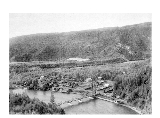
Quesnel Forks, British Columbia
Encyclopedia

Ghost town
A ghost town is an abandoned town or city. A town often becomes a ghost town because the economic activity that supported it has failed, or due to natural or human-caused disasters such as floods, government actions, uncontrolled lawlessness, war, or nuclear disasters...
in the Cariboo
Cariboo
The Cariboo is an intermontane region of British Columbia along a plateau stretching from the Fraser Canyon to the Cariboo Mountains. The name is a reference to the woodland caribou that were once abundant in the region...
region of British Columbia
British Columbia
British Columbia is the westernmost of Canada's provinces and is known for its natural beauty, as reflected in its Latin motto, Splendor sine occasu . Its name was chosen by Queen Victoria in 1858...
, Canada
Canada
Canada is a North American country consisting of ten provinces and three territories. Located in the northern part of the continent, it extends from the Atlantic Ocean in the east to the Pacific Ocean in the west, and northward into the Arctic Ocean...
. It is located the junction of the Quesnel
Quesnel River
The Quesnel River is a major tributary of the Fraser River in the Cariboo District of central British Columbia. It begins at the outflow of Quesnel Lake, at the town of Likely and flows for about northwest to its confluence with the Fraser at the city of Quesnel.- History :Just downstream from...
and Cariboo
Cariboo River
The Cariboo River is a river in the Cariboo District of the Central Interior of British Columbia, Canada. It is a tributary of the Quesnel River, joining that river just northwest of the settlement of Likely. Its reaches below Cariboo Lake were formerly known also as the North Fork Quesnel...
Rivers and is 160 km southeast of Quesnel
Quesnel, British Columbia
-Demographics:Quesnel had a population of 9,326 people in 2006, which was a decrease of 7.1% from the 2001 census count. The median household income in 2005 for Quesnel was $54,044, which is slightly above the British Columbia provincial average of $52,709....
and only 11 km northwest of Likely.
History
Quesnel Forks was founded in 1860 and was a major supply center for the Cariboo Gold RushCariboo Gold Rush
The Cariboo Gold Rush was a gold rush in the Canadian province of British Columbia. Although the first gold discovery was made in 1859 at Horsefly Creek, followed by more strikes at Keithley Creek and Antler Horns lake in 1860, the actual rush did not begin until 1861, when these discoveries were...
. Between 1860 and 1862 it catered to 2,000 or more transient miners annually and a resident population of approximately 100. When gold was discovered on Antler, Lightning and Williams Creek, on the north side of the Snowshoe Plateau, prospectors and packers continued to use the route via Quesnel Forks until a decent trail system was established via the Quesnel and the Cottonwood rivers. The Quesnel Forks Bridge (initially a toll bridge) provided the only access to the village and the mining regions of Keithley Creek and the Snowshoe Plateau until the 1920s. However, when the Cariboo Wagon Road was completed in 1865, Quesnel Forks was bypassed and Barkerville became the center of the mining activity.
By the mid-1870s most of the population had left, but a small, stable community of Chinese miners and merchants remained in the village, supporting a widely dispersed mining community. Many of these people came from the Four Counties region of Kwangtung Province, South China. Following completion of the Canadian Pacific Railway through Ashcroft in 1885 their population increased when many discharged Chinese railroad labourers sought to make a living from gold mining. They were supported by a branch of the Chee Kung Tong Association who erected a two-storey building in the village. During that period the region contained the third largest group of Chinese residents after Victoria and Nanaimo. The CPR also facilitated a hydraulic mining boom in the Cariboo. The Bullion Pit mine nearby produced $1,233,936 (1900 dollar value) over eleven years and attracted large numbers of itinerant men who placed heavy demands on the resources of the village. The horse trail to the Cariboo Road was widened into a wagon road and the Quesnel Forks Bridge strengthened to accommodate heavy wagons in 1895. In that same year a new jail was built at the rear of the Government Agent's house (shown at the head of the bridge in the above photo) and the land around these buildings kept vacant in case of fire. The town was not abandoned until the 1950s.
Modern day
Today, visitors to Quesnel Forks can explore the restored pioneer buildings and historic cemeteryCemetery
A cemetery is a place in which dead bodies and cremated remains are buried. The term "cemetery" implies that the land is specifically designated as a burying ground. Cemeteries in the Western world are where the final ceremonies of death are observed...
. Historical research and work projects began in the 1990s under the leadership of the Likely Cemetery Society and teacher/historian David Falconer. The cemetery area was cleared and secured, graves identified with headboards, and the Chee Kung Tong house stabilized with the assistance of local residents. Thanks to people like Brian Giesbrecht and his crew who have been restoring the old buildings to save them from a slow death into the soil and from the river which is slowly eating away at the banks of the ghost town (half the town has been swept into the river over the past 8 years).
Further reading
- "Gold and Grand Dreams, Cariboo East in the early Years" Marie Elliott Horsdal & Schubart, Victoria, 2000 ISBN 0-920663-71-0
- Ghost Towns of British Columbia Bruce Ramsey Mitchell Press, Vancouver, 1963, OCLC: 39371 ISBN Unknown
- Cariboo-Chilcotin Pioneer People and Places Irene Stangoe ISBN 1-895811-12-0

